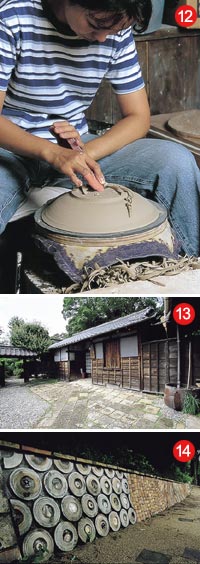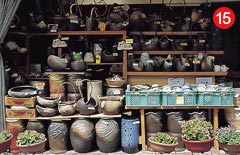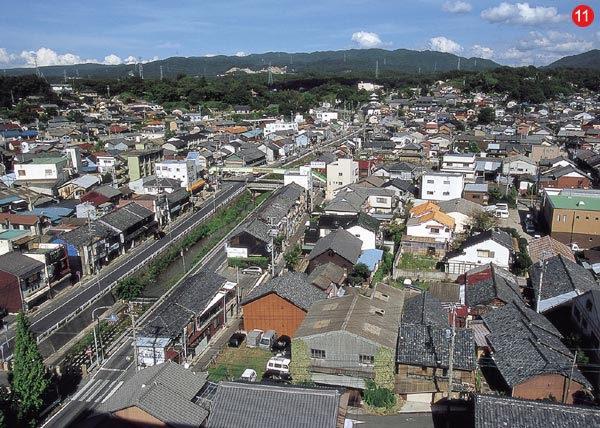 |
|
(12) At a potter's wheel, cutting off pieces of clay to achieve the desired shape. At the Seto Porcelain Painting Institute, visitors are welcome to watch the work and look at finished products. Admission is free.
(13) The Komichi Museum beside the pathway exhibits some of the traditions behind Seto ware.
(14) Kamagaki no Komichi Path was once a road used for transporting earthenware.
|
Seto City—Pottery famous throughout Japan
The other Expo site, the Seto Area, is in the southern part of the city of Seto. Underlying the wooded slopes around the city is a layer of clay ideal for making earthenware and porcelain, so it is not surprising that Seto developed as a center for the ceramic industry. The Seto River flowing through the middle of the city is a natural brown, the same color as the clay.
The area has produced pottery since ancient times, and the industry swung into high gear in the middle of the 11th century. Since then it has produced everything from ordinary tableware to artistic utensils for the tea ceremony. As time passed, Seto became so identified with ceramics that the word seto-mono ("ware from Seto") now means "ceramic ware." After porcelain manufacturing techniques were introduced from Kyushu at the beginning of the 18th century, Seto ware has been sold throughout the country.
Seto blue-and-white porcelain exhibited at the 1873 World Exposition in Vienna was awarded a gold medal in a judged competition. Thus, Seto's association with the World Fair movement has deep roots.
The city has a laid-back atmosphere—long, old wooden buildings, narrow lanes with children playing in the distance, elderly women strolling up walkways that twist one way then another, smoke rising lazily from many kiln chimneys… Go to Seto and you take a voyage into old Japan. The guardian dogs at the entrance to Fukagawa Shrine, the bell at Houn-ji Temple, the hexagon monument standing 4.1 meters high in Toso Park… all these are made of—
you guessed it—ceramic.
The slopes of nearby hills have multi-chambered climbing kilns, locally called hora hongyo-gama. These and other points of interest attest to the long history of pottery production here. A narrow pathway, Kamagaki* no Komichi, still runs through the middle of the Hora-machi kiln district. The pathway is only 400 m long and 180 cm wide, and rather nondescript in itself, but it was once an important road for the industry. In the old days, carts creaked by and workers balanced poles on their shoulders, carrying goods suspended from both ends. Stop and listen a moment—you might hear their high-spirited voices and the clink of earthenware and porcelain being carried along the road.
There are plenty of museums and art galleries to visit. One of them, the Seto Municipal Center of Multimedia and Traditional Ceramics, shows many aspects of Seto's blue-and-white ceramics, both ancient and modern. Here you can get close to the action and watch trainees painting designs on earthenware before it is fired one last time, and others bending over spinning potter's wheels.
Ceramics pervade the life of the city. Of course, there are stores where you can browse and buy. Visitors to Expo 2005 may want to expand their horizons further by exploring the world of seto-mono.
* Kamagaki are walls for a garden or building. Earthenware utensils that were used in the kilns are laid on top of each other something like bricks.

|
 |
(15) A shop with all kinds and sizes of ceramic goods. You will find this type of store in many places in Seto.
|
|


